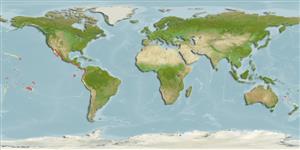Environment: milieu / climate zone / depth range / distribution range
Ecology
Marine; demersal; depth range 10 - 120 m (Ref. 92840). Subtropical
Eastern Central Pacific: Gulf of California to Ecuador.
Size / Weight / Age
Maturity: Lm ? range ? - ? cm
Max length : 14.0 cm SL male/unsexed; (Ref. 92840)
Distinguished by the following characteristics: laterally compressed head and body; large mouth and very oblique; completely scaled body with ctenoid scales; first dorsal with VII spines; pelvic fins fused forming a disc; caudal fin lanceolate (Ref. 92840).
Inhabits muddy bottoms at depths ranging from 10-120 meters (Ref. 92840).
Life cycle and mating behavior
Maturities | Reproduction | Spawnings | Egg(s) | Fecundities | Larvae
Patzner, R.A., J.L. Van Tassell, M. Kovačić and B.G. Kapoor, 2011. The biology of gobies. Enfield, NH : Science Publishers ; Boca Raton, FL : DIstributed by CRC Press, 685 p. (Ref. 92840)
IUCN Red List Status (Ref. 130435)
Threat to humans
Harmless
Human uses
Tools
Special reports
Download XML
Internet sources
Estimates based on models
Preferred temperature (Ref.
123201): 16.2 - 26.9, mean 20.8 °C (based on 45 cells).
Phylogenetic diversity index (Ref.
82804): PD
50 = 0.5005 [Uniqueness, from 0.5 = low to 2.0 = high].
Bayesian length-weight: a=0.00708 (0.00333 - 0.01504), b=3.09 (2.92 - 3.26), in cm total length, based on LWR estimates for this (Sub)family-body shape (Ref.
93245).
Trophic level (Ref.
69278): 3.4 ±0.4 se; based on size and trophs of closest relatives
Resilience (Ref.
120179): High, minimum population doubling time less than 15 months (Preliminary K or Fecundity.).
Fishing Vulnerability (Ref.
59153): Low vulnerability (10 of 100).
